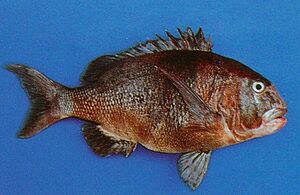Black musselcracker facts for kids
Quick facts for kids Black musselcracker |
|
|---|---|
 |
|
| Conservation status | |
| Scientific classification | |
| Synonyms | |
|
The black musselcracker (Cymatoceps nasutus) is a type of ray-finned fish that lives in the ocean. It belongs to the family called Sparidae, which includes fish like seabreams and porgies. This fish is special because it's the only species in its own group called Cymatoceps. You can only find the black musselcracker in South Africa.
Contents
About the Black Musselcracker's Name
The black musselcracker got its first official description in 1861. A French naturalist named Francis de Laporte de Castelnau gave it the name Chrysophrys nasutus. He found it near Cape Town in Table Bay, South Africa.
Later, in 1938, a scientist named James Leonard Brierley Smith decided this fish was unique enough to have its own special group. He created the group Cymatoceps just for it. This fish is part of the Sparidae family, which is a larger group of fish.
What Does Cymatoceps nasutus Mean?
The scientific name Cymatoceps comes from two words. Cymatos means "swelling" or "bump," and ceps means "head." Scientists think this name refers to the big, fleshy bump that grows on the snouts of older, larger black musselcrackers.
The second part of its name, nasutus, means "large-nosed." This also points to that same big, fleshy bump on its snout. So, its name basically means "bumpy-headed, big-nosed fish"!
What Does the Black Musselcracker Look Like?
The black musselcracker has some unique features that help tell it apart from other fish in its family. It has scales between its eyes and on the lower parts of its dorsal fin (top fin) and anal fin (bottom fin).
Its body is quite deep and a bit flat from side to side. The top of its head slopes gently. But, as the fish gets older and bigger, it grows a fleshy bump on its snout and a hump in front of its eyes.
Adult black musselcrackers are usually a dull dark grey color. Their chin and belly are bright white. Young black musselcrackers are dark greenish-brown with uneven white spots. This fish can grow very large! The biggest one ever recorded was about 150 cm (59 in) (about 5 feet) long and weighed up to 34.4 kg (76 lb) (about 76 pounds).
Where Do Black Musselcrackers Live?
Black musselcrackers are only found in South Africa. They live along the coast from northern KwaZulu-Natal down to False Bay. There have been a few reports of them in Maputo Bay in Mozambique, but it's not common to find them there.
These fish usually live in water that is between 1 and 80 m (3 ft 3 in and 262 ft 6 in) (about 3 to 260 feet) deep. They prefer rocky areas in shallow waters. They rarely go into estuaries, which are places where rivers meet the sea.
Black Musselcracker Life and Habits
Black musselcrackers are usually solitary fish, meaning they like to be alone. They eat a variety of things, mostly molluscs (like mussels and snails), crustaceans (like crabs), and echinoderms (like sea urchins).
Adults live on deeper reefs that have lots of different shapes and hiding spots. Young black musselcrackers prefer shallower reefs, just below where the tide goes out, in water less than 10 m (33 ft) (about 33 feet) deep.
Studies have shown that young and sub-adult fish don't move around much. However, larger adult fish seem to move east along the South African coast. By studying their ear bones (called otoliths), scientists have learned that these fish grow slowly and can live a very long time. The oldest black musselcracker found was 45.5 years old!
Reproduction and Life Cycle
Scientists believe that black musselcrackers are protogynous hermaphrodites. This means they start their lives as females and can later change into males. Off the coast of the Eastern Cape, they lay their eggs (this is called spawning) between May and October.
Adult black musselcrackers are not usually found in the Western Cape. This suggests that the adults travel east to the Eastern Cape and KwaZulu-Natal to reproduce. The smallest female fish found that was able to reproduce was about 53 cm (21 in) (about 21 inches) long. It's thought that about half of the fish are ready to reproduce when they are 10 years old.
They are believed to change from female to male when they are around 70 cm (28 in) (about 27.5 inches) long, which is usually around 18 years old. Fish that are longer than 95 cm (37 in) (about 37.5 inches) are almost always male.
Fishing and Protecting the Black Musselcracker
The black musselcracker is a very popular fish for sport fishing in South Africa. Because so many people want to catch them, this species has been overharvested. This means too many are being caught, which makes it hard for their population to stay healthy.
One big reason they are vulnerable to overharvesting is their slow growth rate. They are often caught before they are old enough to reproduce and have babies.
To help protect the black musselcracker, new fishing rules have been put in place. The main rule is that each fisherman can only catch one fish per day, and that fish must be at least 50 cm (20 in) (about 20 inches) long. Thanks to these new rules, the number of black musselcrackers is starting to increase in some parts of South Africa.


